What do candidates on the 2391 Inspection and Testing course actually do?
PRACTICAL INSPECTION AND TESTING
We begin by looking at how electrical installations should be visually inspected, bearing in mind the type of inspection (minor works, periodic, or initial verification) required. Candidates are provided with course notes to guide them. Candidates go through the long list of inspection items that should be checked, practicing this on demonstration boards that we have specially designed for the course.
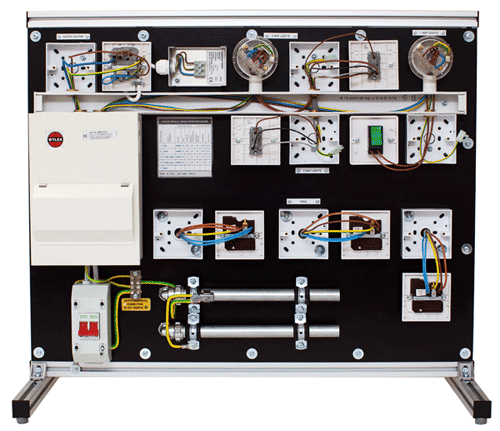 |
One of the simulated electrical installations used on the inspection and testing course |
The course then looks at the required testing, and again we have specially designed practice boards that the candidates perform the testing on. These boards are also used for the live tests.
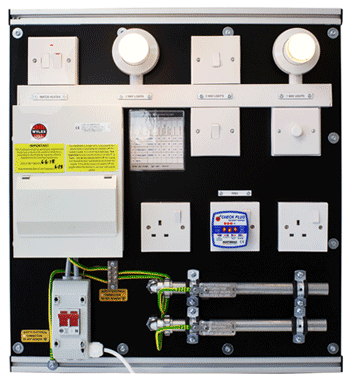 |
One of the simulated electrical installations used on the inspection and testing course |
In order to perform the tests we use a range of industrial test instruments. To begin with we prefer individual test instruments for the testing (rather than multifunction types) as we find the candidates get used to these more easily at this stage of their training.
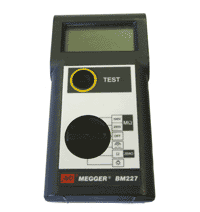 |
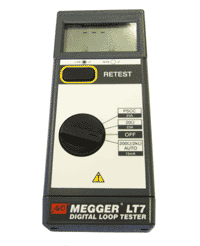 |
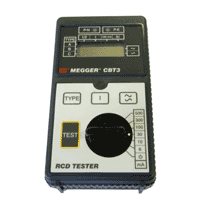 |
One of the continuity and insulation resistance testers used on the C&G 2391 electrical inspection and testing course |
One of the earth fault loop impedance testers used on the C&G 2391 electrical inspection and testing course |
One of the RCD testers used on the C&G 2391 electrical inspection and testing course |
As well as the above testers we also like to get the candidates to use other types, or even encourage them to bring their own testers along. We're quite keen on multi-function testers although some candidates can find these a bit daunting to begin with so we allow the candidates to choose which types they feel most comfortable with. |
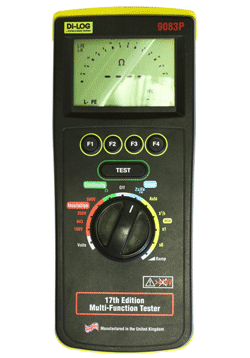 |
One of the Multi-Function testers used on the C&G 2391 electrical inspection and testing course |
Isolation procedures are a crucial part of the inspection and testing course. Voltage testers and proving units are used for this (as well as the necessary padlocks, mcb clasps etc). Without a sound appreciation of the procedures the risk of injury is heightened and any unsound practices lead to failure in the practical assessment. (Many of our candidates already know all about this but we need to ensure that they will perform the isolations to the criteria listed in the C&G 2391assessment.)
The candidates are also taught how to correctly complete the IET paperwork - an important part of the 2391 assessment - so we give them the opportunity to practice this too. Below is one of our voltage testers and proving units used on the 2391 course and an example of some of the IET paperwork that one of our candidates completed:
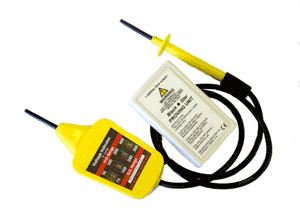 |
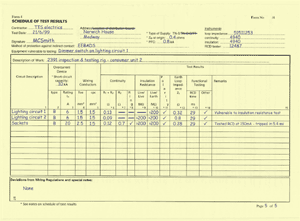 |
One of the voltage testers and proving units used on the 2391 electrical inspection and testing course |
An example of one sheet of the IET paperwork that candidates on the electrical inspection and testing course complete |
The half-day practical assessment takes place during the course (normally on the third day). The practical assessment is conducted on a specially-designed rig which simulates a real electrical installation. The candidates have to safely isolate and test for dead, perform a full inspection and test (consisting of an initial verification and a periodic test) and complete all the necessary IET paperwork as they proceed.
The assessment rig is subdivided into two parts so that both scenarios (a new installation and an existing one) are covered by the assessment. The candidates therefore have to produce the certificates that relate to both initial verification and periodic inspection, and the accompanying inspection and test results schedules. These should all be completed in their correct context, so that for example, the visual inspection would produce C codes for any faults found in the periodic testing but no faults could be reported within the initial verification.
The other parts of the C&G 2391 practical assessment are 1) A series of 14 short answer written questions, which the candidates need to complete on their own, for example: "Describe what is meant by IP6X" and 2) A set of photographs depicting various electrical faults for which they need to identify the fault and allocate it the appropriate C coding: for example there might be a photograph of a metal socket pattress that doesn't appear to be earthed and they would be expected to identify the fault, describe the danger and allocate the correct C code.
Below is an example of one of the candidates' completed test results schedules:
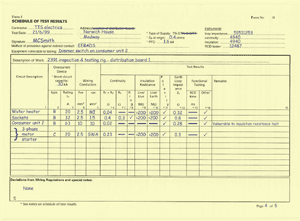 |
One of the IET forms completed by our candidates on the electrical inspection and testing course |
The above assessment is quite a difficult task for many candidates (particularly those who do not have much practical experience of inspection and testing) but we find that our candidates do quite well in this assessment as they pick up all the necessary skills and understanding in the 2 days of the course that precede it.
During the practical part of the 2391 course, candidates are issued with the electricians guide to inspection and testing book. The electricians guide book contains all the most useful reference material about inspection and testing of electrical installations. |
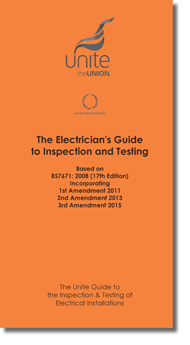 |
Candidates on the 2391 electrical inspection and testing course are given their own copy of our electricians guide book to keep |
THEORY of INSPECTION AND TESTING
In this part of the course candidates are briefed on the quick reference sheets. These help them to revise for the examination. The following are examples of the quick-reference revision sheets.
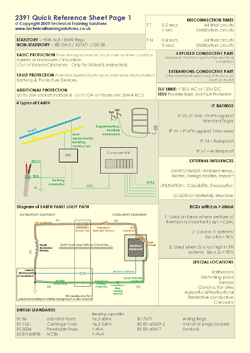 |
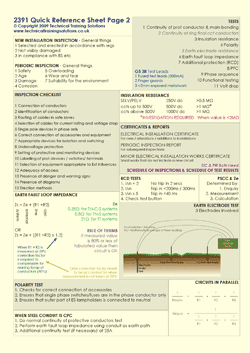 |
One of the reference sheets which help to prepare candidates for the exam on the electrical inspection and testing course |
One of the reference sheets which help to prepare candidates for the exam on the electrical inspection and testing course |
We then work through our course notes which have several examples of questions similar to recent C&G 2391 exam papers. We suggest the best possible answers that they can give whilst discussing the technical issues.
The theory examination usually takes place on the morning of the last day of the course. It's a computer-based multiple-choice examination. The candidates are allowed two hours and there are 60 questions. It's an open-book test, so the candidates can refer to the wiring regs or the on site guide books during the exam.
Some employers prefer that candidates learn about inspection and testing of electrical installations without having to undergo the City & Guilds examinations: Please call us if you would like to discuss this.
If you would like to see some of the equipment used on the electrical inspection and testing course for yourself, then please call us to arrange a visit to our offices in Kent. Alternatively, we can visit you anywhere in the British Isles.



